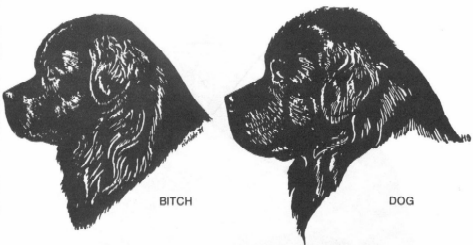HEAD
The head is massive, with a broad skull, slightly arched crown, and strongly developed occipital bone. Cheeks are well developed. Eyes are dark brown. (Browns and Grays may have lighter eyes and should be penalized only to the extent that color affects expression.) They are relatively small, deep-set, and spaced wide apart. Eyelids fit closely with no inversion. Ears are relatively small and triangular with rounded tips. They are set on the skull level with, or slightly above the brow, and lie close to the head. When the ear is brought forward, it reaches to the inner corner of the eye on the same side. Expression is soft and reflects the characteristics of the breed: benevolence, intelligence, and dignity.
Forehead and face are smooth and free of wrinkles. Slope of the stop is moderate, but because of the well developed brow, it may appear abrupt in profile. The muzzle is clean cut, broad throughout its length, and deep. Depth and length are approximately equal, the length from tip of nose to stop being less than that from stop to occiput. The top of the muzzle is rounded, and the bridge, in profile, is straight or only slightly arched. Teeth meet in a scissors or level bite. Dropped lower incisors, in an otherwise normal bite, are not indicative of a skeletal malocclusion and should be considered only a minor deviation.

While the slope of the stop seems abrupt due to the plane of the muzzle and brow of the skull, examination with your hand will show the slope of the stop to be moderate, not steep. The parts of the head blend together smoothly. A flat skull, too little stop, flat cheeks, snipiness, or a "houndy look" all contribute to lack of type. Keep in mind that the ideal bitch head follows that of the ideal dog throughout. The bitch’s head is slightly smaller in proportion to her size than that of a dog. Lack of breadth of skull or breadth and depth of muzzle are no more acceptable in a bitch than in a dog.
Eyes that are prominent, bulgy, set too close together, and/or light colored serve to spoil the soft, sweet Newfoundland expression. The shape of the eyes is a major factor in the desirable sweet expression. Light eyes in browns and grays are not penalized per se, but a poor expression, whether due to eye color, shape, or placement, should be penalized in dogs of any coat color.

The eyelids must fit closely to give good protection to the eyes from water and brush. There should be no evidence of irritation, such as tearing. Inversion of the eyelids (entropion) not only causes eye irritation, but often damages the cornea. Loose lower lids (ectropion) expose the haw and fail to offer proper protection to the eyes. A loose haw also detracts from the expression.
| BACK | CONTENTS | NEXT |